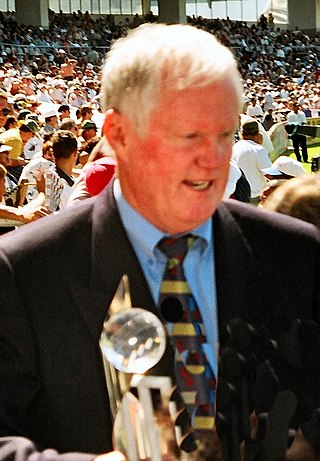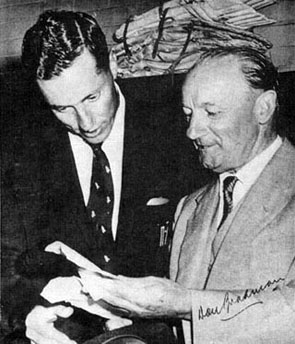
Robert Graeme Pollock is a former cricketer for South Africa, Transvaal and Eastern Province. A member of a famous cricketing family, Pollock is widely regarded as one of South Africa's greatest ever cricketers, and as one of the greatest batsmen in the history of cricket. Despite Pollock's international career being cut short at the age of 26 by the sporting boycott of South Africa, and all but one of his 23 Test matches being against England and Australia, the leading cricket nations of the day, he broke a number of records. His completed career Test match batting average of 60.97 remains the third best behind Sir Don Bradman and Adam Voges.

Dale Willem Steyn is a South African former professional cricketer who played for the South African cricket team. He is regarded by many as the greatest bowler of the Modern Era. Steyn's late swing combined with sheer pace was one of the peculiar qualities which made him stand apart from other bowlers. Many cricketing legends has regarded his length deliveries unplayable when the ball swung. During the 2007–08 season, Steyn achieved a tally of 78 wickets at an average of 16.24, and was subsequently rewarded with the ICC 2008 Test Cricketer of the Year Award. He was named one of the Wisden Cricketers of the Year in 2013, and the Wisden Leading Cricketer in the World for the year 2013 in 2014's Wisden Cricketers' Almanack. In December 2015 he injured his shoulder in the Durban Test against England ; after this injury his career was a short lived one as it was followed by multiple injuries; these injuries were the reason why many cricketing greats didn't even consider post 2015 Steyn as "The Dale Steyn" which the batsmen feared to face. He was featured in Wisden Cricketers of the Decade at the end of 2019. He also was included in the ICC Test Team of the Decade at the end of 2020.

Herbert Wilfred Taylor was a South African cricketer who played 42 Test matches for his country including 18 as captain of the side. Specifically a batsman, he was an expert on the matting pitches which were prevalent in South Africa at the time and scored six of his seven centuries at home. His batting was also noted for quick footwork and exceptional 'backplay'. He became the first South African to pass 2,500 Test runs and was selected one of Wisden's Cricketers of the Year in 1925. In domestic cricket, he played for Natal, Transvaal and Western Province.
Old Wanderers was a cricket ground in Johannesburg, South Africa. The ground hosted 22 Test matches from 1895 to 1939, before being rebuilt as Johannesburg's Park Station in 1946. It has since been replaced by the New Wanderers Stadium.

Trevor Leslie Goddard was a South African cricketer. A left-handed all-rounder, he played 41 Test matches for South Africa from 1955 to 1970. He captained the young South African team on its five-month tour of Australia and New Zealand in the 1963–64 season, levelling the series with Australia, and was also captain in 1964–65 against England in South Africa.

George Alexander Rowe was a South African cricketer.
Alfred Henry Cecil Cooper was a South African cricketer who played a single Test match for the South African national side during the 1913–14 season. Domestically, he played for Transvaal from 1912 to 1928.
George Finlay Bissett was a South African cricketer who played in four Test matches in the 1927–28 season. He was born at Kimberley, Cape Province and died at Botha's Hill, Natal.

When the First World War ended in November 1918, thousands of Australian servicemen were in Europe as members of the First Australian Imperial Force (AIF) and many remained until the spring of 1919. In England, a new first-class cricket season was planned, the first since 1914, and an idea that came to fruition was the formation of an Australian touring side made up of servicemen. Agreement was reached with the Australian Corps HQ in London, commanded by Field Marshal William Birdwood, 1st Baron Birdwood, and the Australian Imperial Force Touring XI was formed, initially under the captaincy of pre-war Test player Charlie Kelleway. Kelleway departed after only six matches following a dispute about the fixtures list. A players' meeting elected future Test player Herbie Collins as team captain for the remainder of the tour, despite the fact that Collins' military rank was lance corporal and there were seven officers in the party. The bulk of the team remained intact for nearly nine months from May 1919, playing 33 matches in Great Britain, ten in South Africa on their way home and then another three in Australia itself before disbanding in February 1920. Of the 46 matches, 39 are adjudged first-class and the team had only four defeats, all of these in England. The players lived on their army pay and all profits from gate money went to an AIF Sports Control Board.

Bruce Mitchell was a South African cricketer who played in 42 Test matches from 1929 to 1949. He was a right-handed opening batsman and played in every Test South Africa played in that period.
This article describes the history of South African cricket from its known beginnings until the end of the First World War in 1918.
The Australia cricket team toured South Africa between February and April 2002 to play three Test and seven ODI matches. Australia won the Test series 2–1 and the ODI series 5–1.
The England cricket team toured South Africa from 8 November 1938 to 14 March 1939, playing five Test matches against the South Africa national team and 13 tour matches against various provincial sides. England won the third Test by an innings and 13 runs, but the other four Tests finished as draws, including the final timeless Test, which was played over the course of 10 days. The final Test was declared a draw, as the England team had to leave to ensure they caught the boat home from Cape Town.
This article describes the history of South African cricket from the end of the Second World War in 1945 to the start of South Africa's cricket isolation in 1970.
South Africa resumed official international cricket in 1991 after the moratorium imposed by the International Cricket Conference in 1970 was lifted. This was the first edition of the sir Vivian Richards trophy. This had restricted official contact with South Africa as a response to the policy of apartheid and South Africa's refusal to select non-white players for their international sporting teams. It formed part of the wider sporting boycott of South Africa during the apartheid era. The South African national team made a short tour of India in 1991. It then played in the 1992 Cricket World Cup in Australia and New Zealand. The decade saw a number of tours of South Africa by major international teams as well as the continued playing of domestic competitions.
This article describes the history of South African cricket from the 2000–01 season. Noted South African players in the 21st century have included Jacques Kallis, Shaun Pollock, Makhaya Ntini, Mark Boucher, Graeme Smith and Herschelle Gibbs.
The England cricket team toured South Africa under the auspices of the Marylebone Cricket Club from December 1905 to March 1906. There were five Test matches, and seven first-class games against South African provincial teams. While the team won a number of their first-class matches, they also lost several, and South Africa won the Test series 4 to 1.
S. B. Joel's XI cricket team in South Africa in 1924–25 was a team of English cricketers which toured South Africa between November 1924 and February 1925 and played 14 first-class cricket matches and seven other games. The tour was an unofficial one: an official tour of Australia organised by the Marylebone Cricket Club took place at the same time.
Alfred Edward Cooper was a South African cricketer who played at first-class level for Griqualand West and Transvaal).
Events in the year 2019 in South Africa.






